Online dating app Bumble (NASDAQ:BMBL) reported Q1 CY2024 results topping analysts' expectations, with revenue up 10.2% year on year to $267.8 million. On the other hand, next quarter's revenue guidance of $272 million was less impressive, coming in 2.4% below analysts' estimates. It made a GAAP profit of $0.19 per share, improving from its loss of $0.01 per share in the same quarter last year.
Bumble (BMBL) Q1 CY2024 Highlights:
- Revenue: $267.8 million vs analyst estimates of $265.5 million (small beat)
- EPS: $0.19 vs analyst estimates of $0.07 ($0.12 beat)
- Revenue Guidance for Q2 CY2024 is $272 million at the midpoint, below analyst estimates of $278.7 million (adjusted EBITDA also guided below for Q2 CY2024)
- Gross Margin (GAAP): 69.6%, down from 70.9% in the same quarter last year
- Free Cash Flow was -$381,000, down from $61.25 million in the previous quarter
- Paying Users: 4.02 million, up 564,500 year on year
- Market Capitalization: $1.30 billion
Founded by the co-founder of Tinder, Whitney Wolfe Herd, Bumble (NASDAQ:BMBL) is a leading dating app built with women at the center.
Online dating apps have disrupted the more traditional ways that people meet romantic partners, by greatly expanding the pool of potential dating partners, allowing people to more readily find those with shared common interests. Today, approximately 40% of couples now meet Online in the U.S., up from 20% in the early-2000s.
Bumble operates two dating apps – Bumble and Badoo. The Badoo app, founded by Andrey Andreev and launched in 2006, differentiates itself by its mantra of “Date Honestly” which is meant to be a mix of both dating app and social discovery app, where one can meet friends with similar interests. It is the market leader in Europe and Latin America.
Bumble launched in 2014, with the innovation of giving women the authority to make the first move under the premise that women would feel more confident and empowered, resulting in higher engagement than on other dating apps. As a result, within North America, Bumble has more female users for every male user than any other dating app, an indication of how well the product resonates with its users. Along the lines of being women-centric, Bumble was one of the first major dating apps to launch automated photo verification (ensuring matches are real people), develop in-app video chat, use machine learning to blur lewd images, and ban obscene images, all with the intention of improving the comfort level of meeting in person. Bumble has also added other mental health resources like a crisis support line, suicide prevention lifeline, and stress management tutorials, all of which bolster its reputation of being a safer, kinder, and more accountable dating app experience. The app itself is simple and works similarly to Tinder, profiles of potential matches are displayed to users, who can "swipe left" to reject a candidate or "swipe right" to indicate interest.
Consumer Subscription
Consumers today expect goods and services to be hyper-personalized and on demand. Whether it be what music they listen to, what movie they watch, or even finding a date, online consumer businesses are expected to delight their customers with simple user interfaces that magically fulfill demand. Subscription models have further increased usage and stickiness of many online consumer services.
Bumble (NASDAQ:BMBL)’s online dating peers include direct rivals Match Group (NASDAQ:MTCH) and Spark Networks (NYSE:LOV), along with social networks like Snapchat (NYSE:SNAP) and Meta Platforms (NASDAQ:FB).
Sales Growth
Bumble's revenue growth over the last three years has been solid, averaging 19.7% annually. This quarter, Bumble reported mediocre 10.2% year-on-year revenue growth, in line with analysts' expectations.
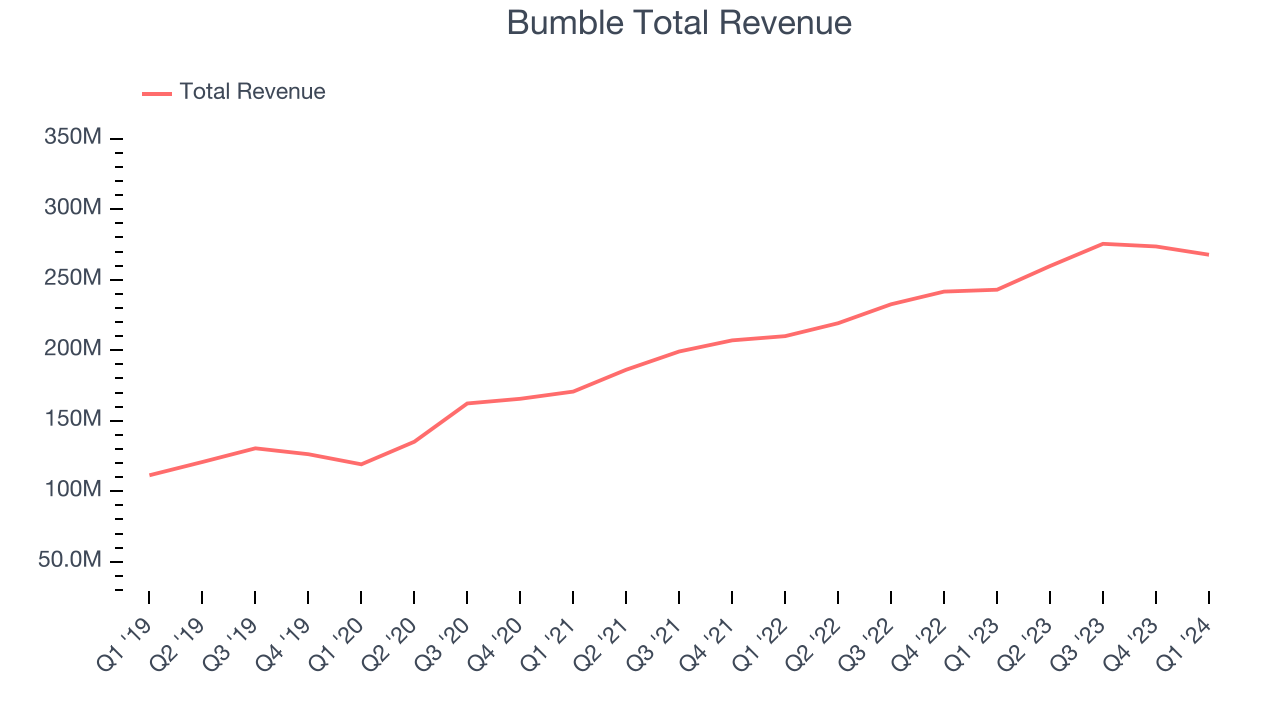
Guidance for the next quarter indicates Bumble is expecting revenue to grow 4.7% year on year to $272 million, slowing from the 18.5% year-on-year increase it recorded in the comparable quarter last year. Ahead of the earnings results, analysts were projecting sales to grow 9.7% over the next 12 months.
Usage Growth
As a subscription-based app, Bumble generates revenue growth by expanding both its subscriber base and the amount each subscriber spends over time.
Over the last two years, Bumble's active buyers, a key performance metric for the company, grew 14.6% annually to 4.02 million. This is solid growth for a consumer internet company.
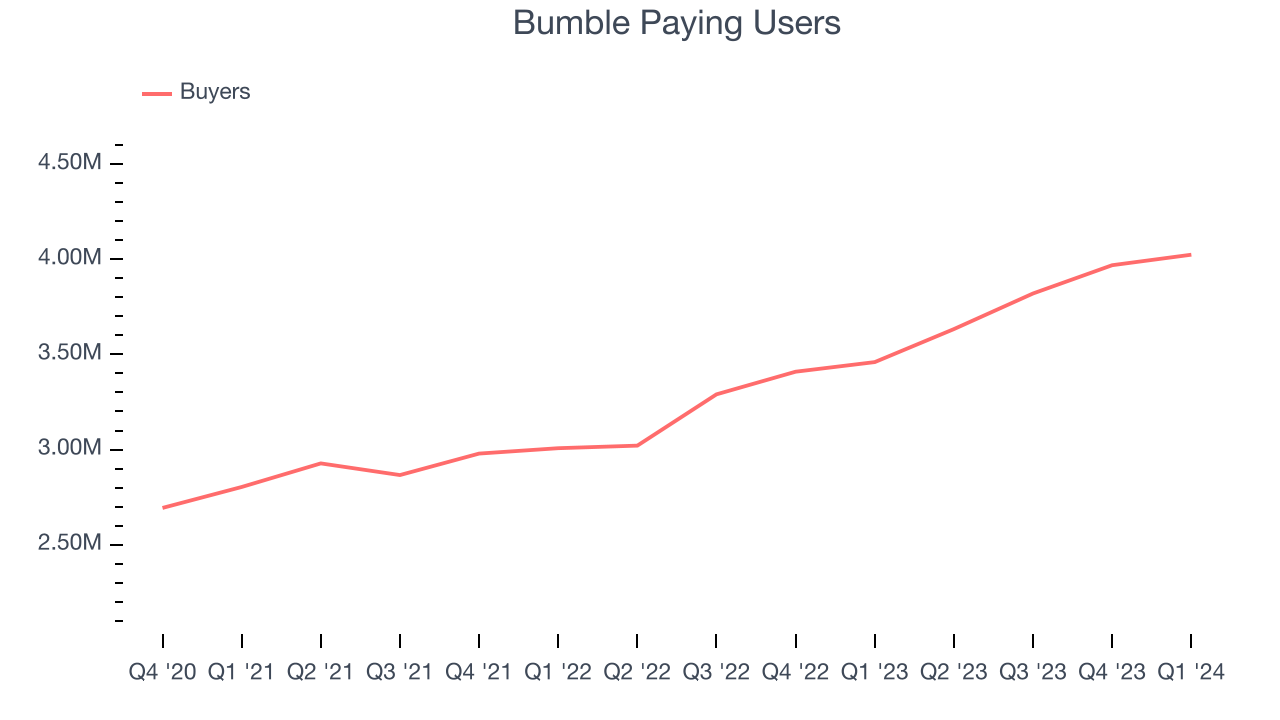
In Q1, Bumble added 564,500 active buyers, translating into 16.3% year-on-year growth.
Revenue Per Buyer
Average revenue per buyer (ARPB) is a critical metric to track for consumer internet businesses like Bumble because it measures how much the average buyer spends. ARPB is also a key indicator of how valuable its buyers are (and can be over time).
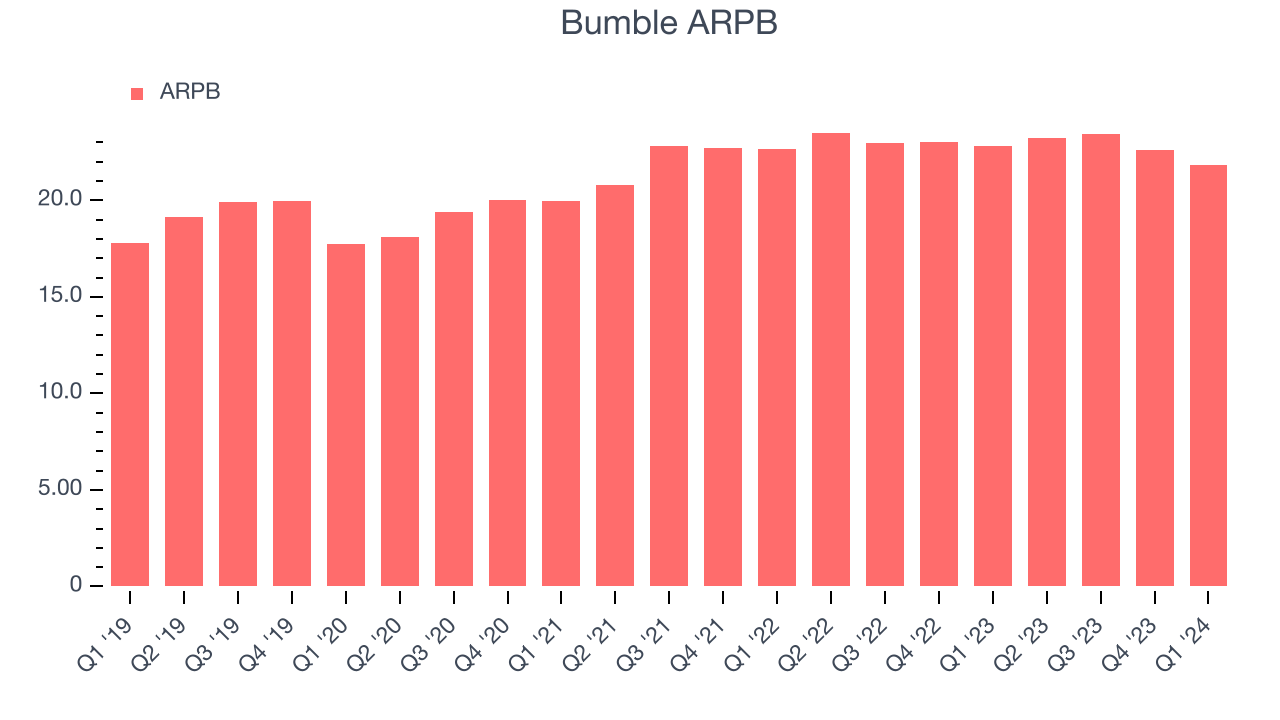
Bumble's ARPB growth has been subpar over the last two years, averaging 1.4%. The company's ability to increase prices while maintaining its active buyers, however, shows the value of its platform. This quarter, ARPB declined 4.3% year on year to $21.84 per buyer.
Pricing Power
A company's gross profit margin has a major impact on its ability to exert pricing power, develop new products, and invest in marketing. These factors may ultimately determine the winner in a competitive market, making it a critical metric to track for the long-term investor.
Bumble's gross profit margin, which tells us how much money the company gets to keep after covering the base cost of its products and services, came in at 69.6% this quarter, down 1.3 percentage points year on year.
For internet subscription businesses like Bumble, these aforementioned costs typically include customer service, data center and infrastructure expenses, and royalties and other content-related costs if the company's offering includes features such as video or music services. After paying for these expenses, Bumble had $0.70 for every $1 in revenue to invest in marketing, talent, and the development of new products and services.
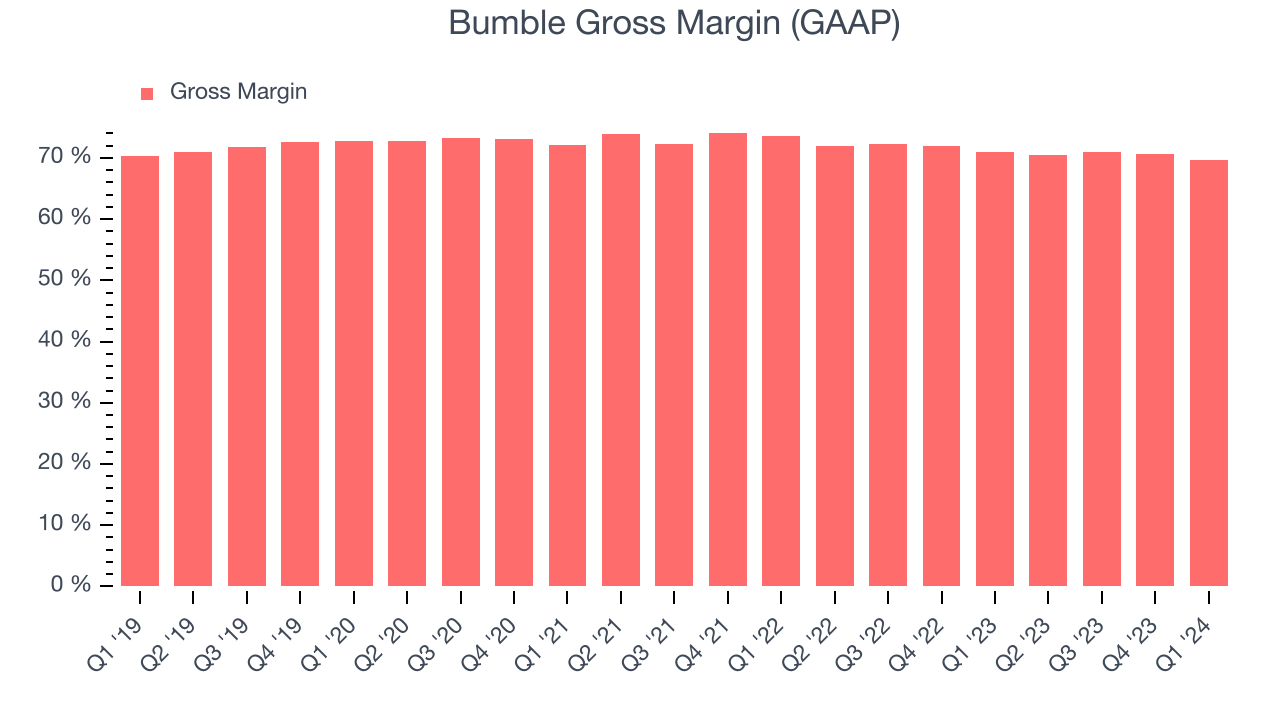
Despite declining over the last 12 months, Bumble still retains strong gross margins, averaging 70.4%. These robust unit economics, driven by the company's attractive business model and strong pricing power, are higher than most consumer internet peers and allow Bumble to make more investments in product and marketing.
User Acquisition Efficiency
Consumer internet businesses like Bumble grow from a combination of product virality, paid advertisement, and incentives (unlike enterprise software products, which are often sold by dedicated sales teams).
Bumble is efficient at acquiring new users, spending 35.7% of its gross profit on sales and marketing expenses over the last year. This level of efficiency indicates relatively solid competitive positioning, giving Bumble the freedom to invest its resources into new growth initiatives.
Profitability & Free Cash Flow
Investors frequently analyze operating income to understand a business's core profitability. Similar to operating income, adjusted EBITDA is the most common profitability metric for consumer internet companies because it removes various one-time or non-cash expenses, offering a more normalized view of a company's profit potential.
This quarter, Bumble's EBITDA came in at $74.04 million, resulting in a 27.6% margin. Additionally, Bumble has demonstrated extremely high profitability over the last four quarters, with average EBITDA margins of 27%.
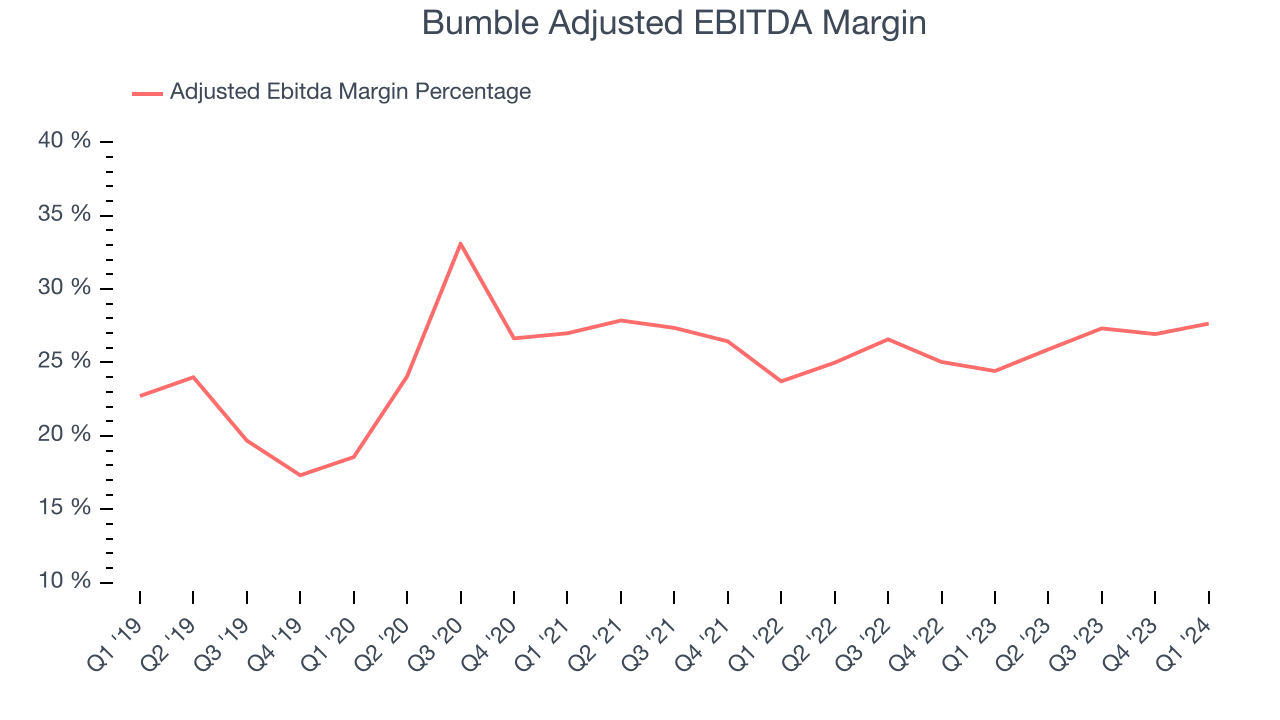
If you've followed StockStory for a while, you know that we emphasize free cash flow. Why, you ask? We believe that in the end, cash is king, and you can't use accounting profits to pay the bills. Bumble burned through $381,000 in Q1, with cash flow turning negative year on year.
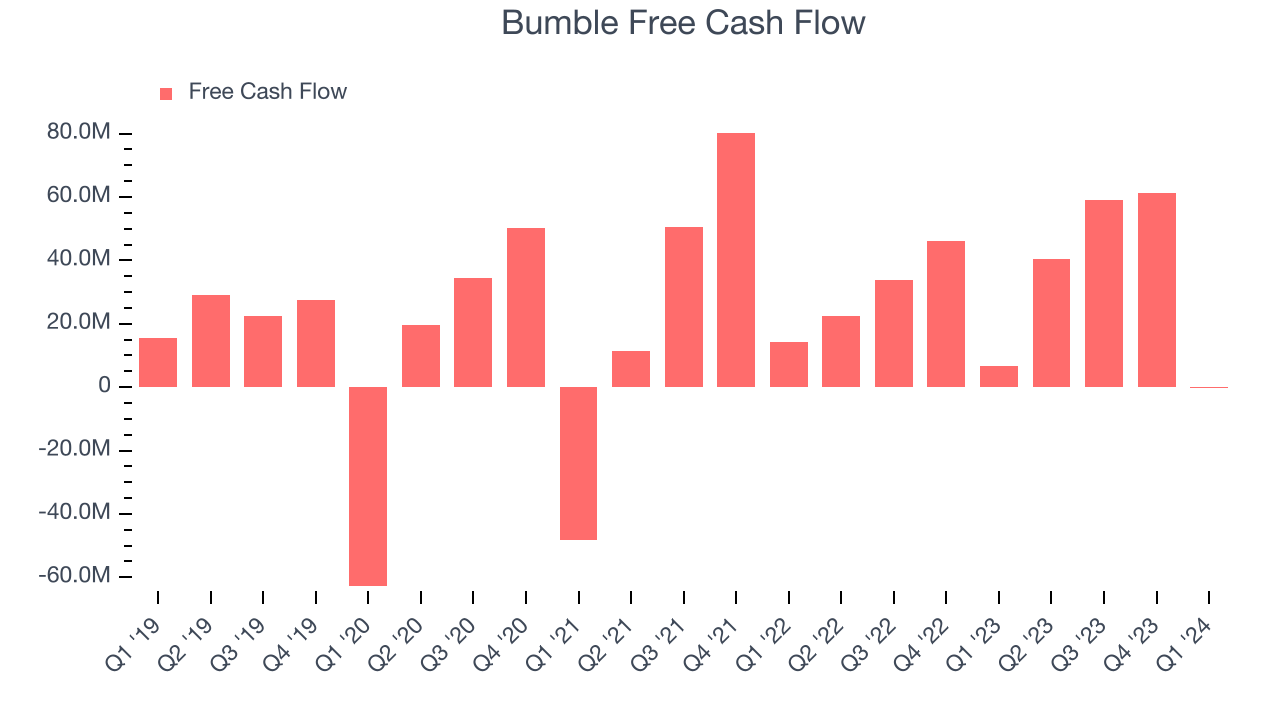
Bumble has generated $160.2 million in free cash flow over the last 12 months, an impressive 14.9% of revenue. This high FCF margin stems from its asset-lite business model and strong competitive positioning, giving it the option to return capital to shareholders or reinvest in its business while maintaining a cash cushion.
Key Takeaways from Bumble's Q1 Results
It was great to see Bumble increase its number of buyers this quarter. On the other hand, its revenue and adjusted EBITDA guidance for next quarter missed analysts' expectations and its revenue growth stalled. Looking to the full year, the company still thinks it can hit previously-given guidance and reiterated its revenue and adjusted EBITDA outlook for 2024. Overall, this was a mixed quarter for Bumble. The stock is up 5% after reporting and currently trades at $10.76 per share.
Is Now The Time?
Bumble may have had a mixed quarter, but investors should also consider its valuation and business qualities when assessing the investment opportunity.
We think Bumble is a good business. We'd expect growth rates to moderate from here, but its revenue growth has been solid over the last three years. And while its ARPU has grown slowly over the last two years, the good news is its gross margins are a strong starting point for the overall profitability of the business. On top of that, its strong free cash flow generation allows it to invest in growth initiatives while maintaining an ample cash cushion.
At the moment, Bumble trades at 3.7x next 12 months EV-to-EBITDA. There's definitely a lot of things to like about Bumble and looking at the consumer internet landscape right now, it seems that the company trades at a pretty interesting price.
Wall Street analysts covering the company had a one-year price target of $15.22 per share right before these results (compared to the current share price of $10.76), implying they saw upside in buying Bumble in the short term.
To get the best start with StockStory check out our most recent Stock picks, and then sign up to our earnings alerts by adding companies to your watchlist here. We typically have the quarterly earnings results analyzed within seconds of the data being released, and especially for the companies reporting pre-market, this often gives investors the chance to react to the results before the market has fully absorbed the information.
